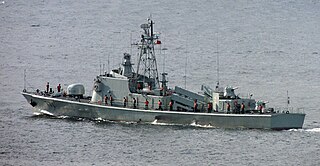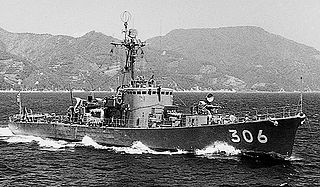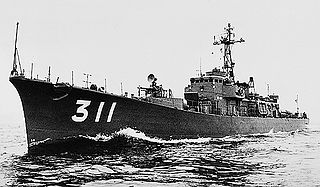
The Project 633 class is a class of Soviet diesel-electric submarine, built between 1957 and 1961. A Chinese variant, Type 033, was built in China from 1962 to 1984.
The Kaichū type submarine submarines were double-hulled medium-sized submarines of the Imperial Japanese Navy during World War II. They were derived from the Kaigun-shiki Chū-gata Sensuikan.

The Type 037 corvette is a series 400–500 ton corvette type classes in service with the People's Liberation Army Navy. Unlike western navies, the People's Liberation Army Navy does not have dedicated patrol boats in its inventory. Instead, a large variety of corvette type classes, in the form of missile boats and submarine chasers fulfill the tasks of patrolling China's territorial waters. The Egyptian Navy operates eight vessels.

The I-351-class submarine was a class of tanker/transport submarines built for the Imperial Japanese Navy (IJN) during World War II. The IJN called this type of submarine Senho type submarine. The type name, was shortened to Hokyū Sensuikan. The IJN designed these submarines to support flying boats in forward areas. By the time the first submarine was finished, this capability was no longer needed and she was converted into a tanker. That boat, I-351, was sunk on the return leg of her second voyage in 1945; the second boat, I-352, was destroyed by an American air raid before she was completed. Four additional submarines were planned, but were cancelled before they were laid down.

The No.251 class auxiliary submarine chaser was a class of submarine chasers of the Imperial Japanese Navy (IJN), serving during World War II. 3 vessels were built in 1936 – 1939 under the Maru 2 Programme. They have two subclasses, this article handles them collectively.

Peng Shilu was a Chinese nuclear engineer. Hailed as "the father of China's nuclear submarines" and the "father of China's naval nuclear propulsion", he was the first chief designer of the country's nuclear submarine project, directing his team to build China's first generation of nuclear submarines. He was also the main designer for China's first nuclear power plants, and was an academician of the Chinese Academy of Engineering. He served as deputy minister for China's Ministry of Shipbuilding Industry, and Ministry of Hydropower.
Cha-156 or No. 156 was a No.1-class auxiliary submarine chaser of the Imperial Japanese Navy that served during World War II.
I-67 was a Kaidai-type cruiser submarine of the Imperial Japanese Navy. A KD5 sub-class boat, she sank in a training accident in 1940.

Changzheng 1 (401) is a Type 091 nuclear attack submarine of the People's Liberation Army Navy.

Changcheng 237 is a Type 033 submarine of the People's Liberation Army Navy.
Changcheng 303 is a Type 033 submarine of the People's Liberation Army Navy.
Changcheng 349 is a Type 033 submarine of the People's Liberation Army Navy.
Changcheng 280 is a Type 033 submarine of the People's Liberation Army Navy.
Changcheng 353 is a Type 035 submarine of the People's Liberation Army Navy.

The Kari-class submarine chaser was a class of submarine chasers of the Japan Maritime Self-Defense Force after the Second World War, in the mid-1950s.

The Kamome-class submarine chaser was a class of submarine chasers of the Japan Maritime Self-Defense Force after the Second World War, in the mid-1950s.

The Umitaka-class submarine chaser was a class of submarine chasers of the Japan Maritime Self-Defense Force after the Second World War, in the late 1950s.

The Mizutori-class submarine chaser was a class of submarine chasers of the Japan Maritime Self-Defense Force after the Second World War, in the early 1960s.

JDSHayabusa(PC-308) was a submarine chaser of the Japan Maritime Self-Defense Force (JMSDF) in the mid-1950s. She was later converted to an accommodation ship and redesignated as ASY-91. She was the third vessel to inherit the name after the Imperial Japanese Navy's Hayabusa-class torpedo boat Hayabusa and Ōtori-class torpedo boat Hayabusa.











